P11.07 24 HOUR AMBULATORY CENTRAL BP MEASUREMENT REVEALS SIGNIFICANT VARIATION IN PULSE PRESSURE AMPLIFICATION BETWEEN DAY AND NIGHT
- DOI
- 10.1016/j.artres.2011.10.163How to use a DOI?
- Open Access
- This is an open access article distributed under the CC BY-NC license.
Introduction: Brachial ambulatory blood pressure monitoring (ABPM) provides greater predictive value for cardiovascular events than clinic blood pressure (BP) readings. However, systolic BP varies throughout the arterial tree, such that brachial BP readings do not reliably indicate central (aortic) pressure. As yet, 24 hour ambulatory central BP, and central to peripheral pressure amplification have not been described.
Methods: 24 hour ambulatory brachial and central BP monitoring was undertaken in 122 healthy, treatment-naive individuals (71 females), using the mobilograph device (IEM, Germany). The mean age was 48±20 years (range 18–80 years). Ambulatory measurements were made every 30 minutes during the day and every 60 minutes overnight. Clinic (seated) BP was also assessed, prior to undertaking ambulatory measurements.
Results: Mean clinic (seated) BP was 130±21/79±11mmHg. During the daytime, mean ambulatory BP was 125±14/80±12mmHg (brachial) and 115±14/82±12mmHg (central). During the nighttime, both brachial (115±16/70±12mmHg) and central (107±15/71±11mmHg) ambulatory BP fell significantly (P<0.001 for all comparisons, Figure 1). However, the ratio between brachial and central pulse pressures (pulse pressure amplification) was significantly higher during the daytime (1.38±0.15) compared with nighttime (1.23±0.11, P=0.002).

Conclusions: Monitoring of ambulatory central BP reveals significant variation in pulse pressure amplification over a 24 hour period. These data indicate that ambulatory central and brachial BP are differentially affected by the activities of daily living. Further studies are required to investigate whether the prognostic value of ambulatory central BP is superior to ambulatory brachial BP.
Cite this article
TY - JOUR AU - J.C. Smith AU - L. Day AU - J. Woodcock-Smith AU - K. Miles AU - M. Watts AU - C.M. McEniery AU - I.B. Wilkinson PY - 2011 DA - 2011/11/29 TI - P11.07 24 HOUR AMBULATORY CENTRAL BP MEASUREMENT REVEALS SIGNIFICANT VARIATION IN PULSE PRESSURE AMPLIFICATION BETWEEN DAY AND NIGHT JO - Artery Research SP - 194 EP - 194 VL - 5 IS - 4 SN - 1876-4401 UR - https://doi.org/10.1016/j.artres.2011.10.163 DO - 10.1016/j.artres.2011.10.163 ID - Smith2011 ER -
